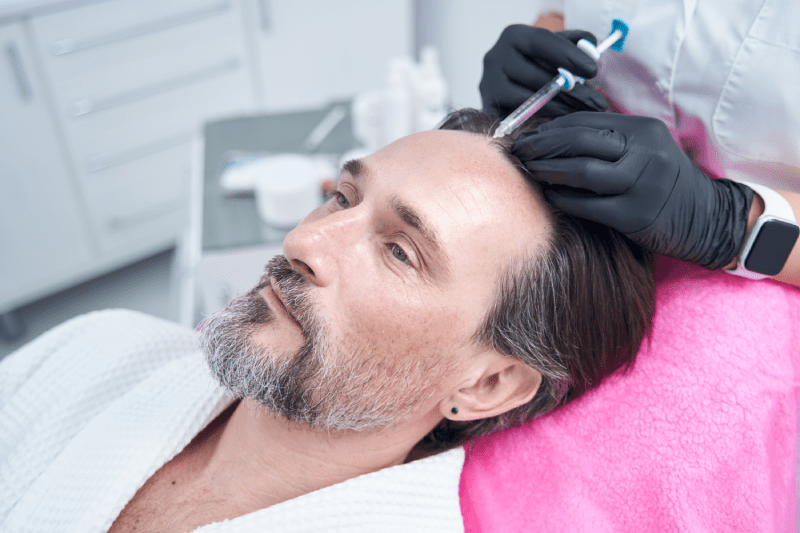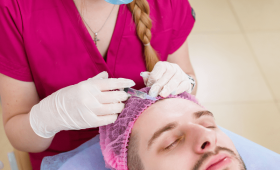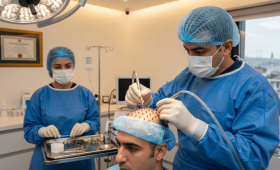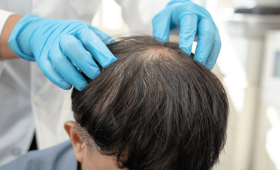Turkey is globally recognised as a “Hair Transplant Paradise” thanks to its high-standard services, state-of-the-art methods, and unmatched cost advantages in the field of hair restoration. Thousands of patients from abroad choose expert teams in Turkey to meet their aesthetic expectations and achieve permanent results. In this guide, you will find all the details you need to know before embarking on your hair transplant journey and the answers to the most frequently asked questions. Remember, you should always contact Cure Holiday for a personalised treatment plan and packages tailored to your budget.
Why Are Hair Transplant Costs So Affordable In Turkey?
The primary reasons why hair transplant prices in Turkey are more affordable compared to the United Kingdom or other European countries are the low general operating costs and the advantage provided by the exchange rate. Clinics face lower expenses for personnel, energy, rent, and laboratory services. Furthermore, international patients paying in Sterling or Euro gain a direct cost advantage due to the Turkish Lira’s value against foreign currencies. This allows clinics to offer treatments at much more accessible prices without compromising service quality, utilizing the same high-quality equipment and expertise. Cure Holiday works diligently to provide you with the most comprehensive and affordable packages available.
Which Techniques Are Most Commonly Used In Hair Transplant Procedures?
The two main techniques that yield the most common and successful results in hair transplantation in Turkey are FUE (Follicular Unit Extraction) and DHI (Direct Hair Implantation) methods. FUE is based on the principle of extracting hair follicles individually from the donor area and transplanting them into channels created in the recipient area, making it ideal for covering large areas. DHI, on the other hand, involves the direct implantation of grafts using a specialised tool (the Choi implanter pen), completing the channel creation and root placement in a single step. The choice of technique is determined by the patient’s hair loss pattern, the density of the donor area, and the expected aesthetic outcomes.
What Services Are Generally Included In Hair Transplant Packages?
Hair transplant packages in Turkey are typically offered on an “all-inclusive” concept, designed with the comfort of international patients in mind. These packages fundamentally cover pre-operative consultations and analyses, the hair transplant procedure itself, all necessary medications and medical supplies, and the initial post-operative wash and care procedures. Additionally, all transfer services between the airport and the clinic, and often 2-3 nights of accommodation in luxury hotels, are an integral part of the package. These comprehensive services ensure that the patient’s travel and treatment process is hassle-free from start to finish.
What Is The Hair Transplant Experience Of Clinicians In Turkey?
Hair transplant teams in Turkey have accumulated a unique level of international experience in this field due to high demand and large patient volumes. Many clinicians and surgical teams have successfully performed hundreds of operations on patients with various hair and skin types, not only from Turkey but from all corners of the world. This continuous practical experience enables the teams to generate quick and effective solutions even in the most challenging cases. This profound expertise is one of the most critical factors that directly enhances the naturalness and success rate of hair transplant results.
How Long Is The Required Stay In Turkey For The Hair Transplant Procedure?
The minimum required stay in Turkey for the hair transplant procedure is generally three days (two nights of accommodation). The first day is allocated for arrival and consultation, the second day for the operation, and the third day for the first wash and control procedures. However, a stay of 4-5 days may be recommended for patients to rest and undergo the initial recovery phase more comfortably. This duration is considered ideal for completing the procedure, having the initial care performed by experts, and conducting all necessary checks for a safe return home.
How Is The Naturalness Of Hair Transplant Results Ensured?
Achieving a natural look is the most important success criterion for hair transplant results, and this depends on correct planning and application during the procedure. To ensure naturalness, critical steps include personalising the hairline design to suit the patient’s facial structure and age, implanting the hair follicles extracted from the donor area at the correct angles and directions, and using single grafts along the front line. Experienced teams perform the implantation by mimicking the natural growth pattern of the hair, thereby preventing an artificial appearance when the transplanted hair grows out.
What Solutions Are Applied In Case Of Donor Area Insufficiency?
In situations where the donor area (usually the back of the head) is insufficient or hair density is low, different solutions may be applied depending on the clinic. The most common alternative solution is using body hair (BHT – Body Hair Transplant); however, this is only preferred if the body hairs are thick and strong enough. Another method is to concentrate the limited number of grafts in the most strategic and visible areas to maximise the aesthetic impact. Most importantly, the patient’s expectations must be realistically adjusted according to the available donor capacity.
What Should Be The Preparation Process Before The Hair Transplant Procedure?
There are several crucial preparation steps that patients must adhere to before the hair transplant procedure. Patients are usually asked to stop or minimise alcohol and nicotine consumption for at least one week before the operation, as these can negatively impact the healing process. Blood-thinning medications and certain vitamin supplements should also be discontinued a few days before the operation with the physician’s approval. Furthermore, wearing comfortable clothes and ensuring the hair is clean on the day of the operation are essential. These preparations are critical for maximising the operation’s success and the patient’s safety.
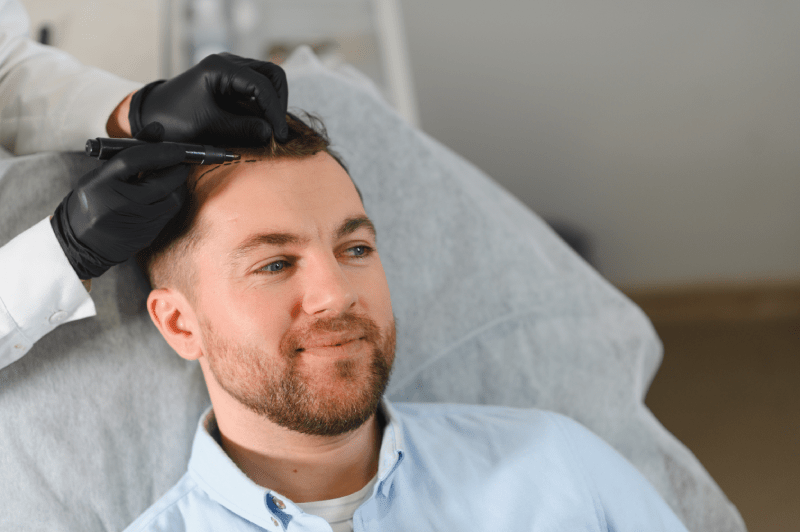
What Is The Price Difference Between FUE And DHI Techniques?
The price difference between FUE and DHI techniques usually leans towards the DHI technique being slightly more expensive. The reason for this is that DHI requires more time, greater precision, and more expertise from the operating team. Although DHI is less invasive due to the direct placement of grafts, the use of special tools (Choi pens) and the specific nature of the technique can increase costs. However, package prices in Turkey are often determined not strictly by the technique but by the number of grafts to be transplanted and the overall package inclusions.
Is Pain And Discomfort Felt During Hair Transplantation?
Since the hair transplant procedure is performed under local anaesthesia, the patient does not feel any pain or discomfort during the operation itself. The only discomfort that might be felt is a brief stinging sensation at the initial moment when the local anaesthesia injections are applied. Advanced clinics aim to minimise this initial discomfort by using needle-free anaesthesia devices. In the post-operative period, any mild pain or soreness is easily controlled with prescribed painkillers, ensuring the patient’s comfort throughout their recovery.
How Long Does The Post-Hair Transplant Recovery Period Last?
The post-hair transplant recovery process typically progresses in three stages. Within the first 10-14 days, the scabs fall off, and the transplanted area returns to a more normal appearance. The shock shedding period begins around the end of the first month, and most of the transplanted hairs fall out. The actual healing and new hair growth commence after 3 to 4 months. The final results and full density can take around 9 to 12 months to become fully visible. Adhering to the care instructions provided by your clinic is critical during this entire process.
Does The Number Of Grafts Directly Affect The Hair Transplant Price?
Yes, the number of grafts to be transplanted is the most important factor that directly influences the hair transplant price. A graft is a follicular unit that typically contains 1 to 4 hair strands. Many clinics base their pricing on a fixed number of grafts (e.g., 4000 grafts) or guarantee a maximum number of grafts. More grafts require more working hours, more consumables, and a larger team, thus increasing the cost. Therefore, when a greater number of grafts is needed for extensive hair loss, the price naturally increases proportionally.
Are The Materials Used For Hair Transplantation In Turkey Up To International Standards?
Clinics in Turkey focused on health tourism use materials compliant with the highest international standards to maintain global competitiveness. This means that the single-use surgical instruments, FUE punches, DHI pens, and wound care kits used in the operations are FDA and CE approved. Maintaining high quality is critical for maximizing both the success of the operation and the safety of the patient. The minor difference in the cost of materials stems solely from the supply chain and lower operating expenses in the region.
When Do The Scabs That Form After Hair Transplant Fall Off?
The small scabs that form on the transplanted area after hair transplantation appear as a result of the micro-bleeding that occurs during graft placement drying out. These scabs are expected to have fallen off within 10 to 14 days after the operation. Meticulous adherence to the clinic’s instructions for the first and subsequent washes helps to gently soften and shed the scabs. It is critically important to allow the scabs to fall off naturally to avoid damaging the transplanted roots; patients must never pick at them with their fingernails.
When Does Shock Shedding Start And How Long Does It Last After Hair Transplantation?
“Shock shedding” (Telogen Effluvium) after hair transplantation, which occurs as the transplanted hair follicles enter a resting phase, usually begins 3 to 6 weeks after the operation. This is a natural and expected part of the healing process and should not cause concern. The shedding period typically lasts for about a month. The hair that sheds are only the strands, not the roots themselves, and after the shedding, the follicles will start producing healthy, permanent hairs again. This process is a necessary restructuring for the new, permanent hair to begin growing.
What Medications And Supplements Should Be Used During The Recovery Period?
Medications and supplements to be used during the recovery process are prescribed by the physician to minimise the risk of post-operative infection and accelerate healing. These typically include antibiotics, painkillers, and anti-swelling medications. Additionally, special hair vitamins and sprays containing biotin, zinc, and B vitamins may be recommended to nourish the hair follicles and mitigate the shock shedding period. Patients must use these medications regularly and strictly according to the clinic’s instructions for optimal recovery.
Is PRP Treatment Included In The Hair Transplant Cost?
PRP (Platelet Rich Plasma) treatment involves injecting plasma, derived from the patient’s own blood and enriched with growth factors, into the scalp. This treatment accelerates the nourishment of hair follicles, supports healing, and increases the survival rate of the transplanted grafts. Many comprehensive hair transplant packages in Turkey include PRP treatment without an additional cost. This is a significant added service that enhances the quality of the treatment and helps the transplanted grafts grow stronger, making it a key factor to consider when selecting a package.
When Can Sports And Exercise Be Resumed After Hair Transplantation?
The time to resume sports and exercise after a hair transplant varies according to the intensity of the activity. Non-strenuous activities, such as light-paced walking, can generally be performed within the first week after the operation. However, intense exercises that involve heavy lifting, cardio, or cause excessive sweating on the scalp, as well as sports with a risk of impact, should be avoided for at least one month. Sweating can increase the risk of infection, and tension on the scalp can potentially harm the grafts.
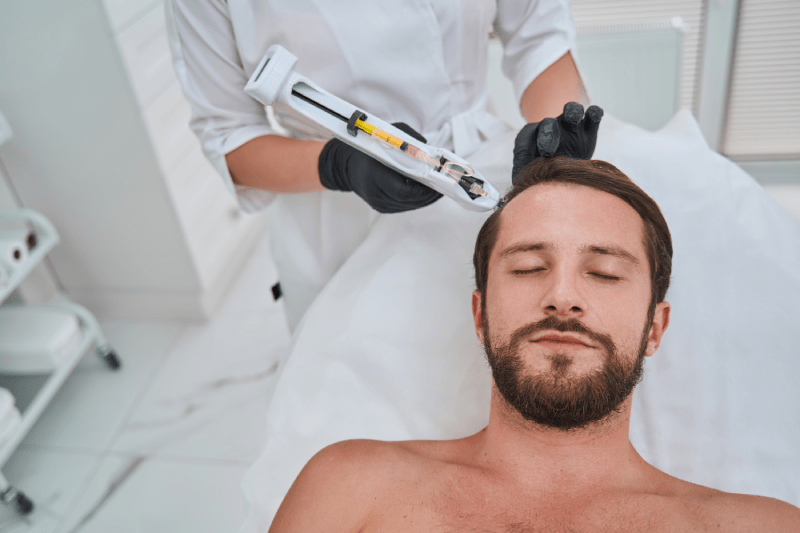
Is Travelling To Turkey For Hair Transplantation Comfortable In Terms Of Travel And Accommodation?
Travelling for a hair transplant is extremely comfortable, thanks to Turkey’s well-developed infrastructure in health tourism. Packages offered by Cure Holiday include private meet-and-greet services at the airport, comfortable transfers to the clinic and hotel, and typically luxury accommodation options in central locations. Communication issues are eliminated through interpreter services, allowing patients to focus solely on recovery. This integrated service approach transforms the treatment process into a stress-free and pleasant experience for international patients.
How Should The Hair Washing Procedure Be Performed After Hair Transplantation?
The first hair wash after transplantation is generally performed by specialists at the clinic on the third day following the operation. This wash is critically important for gently softening the scabs and cleansing the recipient area. For subsequent washes, the patient is provided with special shampoos and lotions, and the washing technique is taught in detail. Washing should be done gently, using only the fingertips, never the nails, to the transplanted area, and this delicate process must continue for approximately 10-14 days.
How Do Smoking And Alcohol Consumption Affect Hair Transplant Success?
Smoking and alcohol consumption are two major factors that negatively affect the success of hair transplantation. Smoking constricts blood vessels and reduces oxygen levels in the blood, preventing the essential nutrients and oxygen required by the hair follicles from reaching the transplanted area. This decreases the graft survival rate and slows down wound healing. Alcohol can thin the blood and interact with certain medications, increasing pre- and post-operative risks. Therefore, refraining from these habits for a specified period both before and after the operation is strictly necessary.
How Long Is The Hair Transplant Guarantee Valid?
The hair transplant guarantee usually covers the commitment that the transplanted hair follicles will grow permanently. Most reliable clinics provide this commitment for a period of 12 to 18 months. The warranty is valid for results that fall below the expected success rate due to technical errors. However, the guarantee does not cover losses caused by the patient’s own fault (accident, improper care, etc.) or the progression of natural hair loss. It is important to review your contract and clarify the warranty details with Cure Holiday.
Why Is Aesthetic Hairline Design So Important?
Hairline design is the most important aesthetic phase of the hair transplant procedure. In a successful hair transplant, the naturalness of the hairline and its suitability for the patient’s age, face shape, and frontal muscles are as important as the density of the transplanted hair. A poorly designed hairline can make the transplant look artificial. Expert teams determine a personalised line using detailed measurements to create the most natural look that balances the patient’s facial features.
When Can Sexual Intercourse Be Resumed After Hair Transplantation?
The time to return to sexual activity after a hair transplant is generally recommended to be one week (7 days) to avoid pressure and sweating on the scalp. Sexual intercourse requiring intense physical activity can increase blood pressure in the scalp, which could potentially cause newly implanted grafts to shift or be damaged during the first sensitive days. Being cautious during the first week and adhering to the physician’s instructions is critical for preserving the success of the transplant.
Which Seasons Are Preferred For Hair Transplantation In Turkey?
The most suitable season for the hair transplant procedure is generally autumn and winter. This is because the transplanted area needs to be protected from direct sunlight and excessive sweating after the operation. Sunlight can cause pigmentation (spotting) in the transplanted area, while excessive sweating increases the risk of infection. However, if patients’ travel schedules are inflexible, the operation can be performed in the summer; in this case, extra caution must be taken with strong sun protection and hat use (after the first month).
Is Needle-Free Anaesthesia Included In The Hair Transplant Cost?
With advancing technology, needle-free anaesthesia applications have become popular for patients with a fear of needles during hair transplantation. These devices inject the anaesthetic substance under the skin using high pressure, eliminating the sensation of a needle. Many competitive and comprehensive packages in Turkey include the needle-free anaesthesia application at no extra charge to enhance patient comfort. You should confirm with Cure Holiday whether this service is included in your specific package.
Is Psychological Support Available Before And After Hair Transplantation?
The hair transplant process is a psychological journey for patients as much as it is a physical change. Especially the outcome expectations and the healing period can create uncertainty. Institutional and patient-focused clinics offer psychological support and informational services through patient coordinators before and after the operation. Addressing the patient’s concerns, setting realistic expectations about the process, and maintaining high morale are extremely important for the overall success and satisfaction of the treatment.
What Is The Donor Area Healing Time And Scarring Status?
When the FUE technique is used, very small, millimetre-sized punctures typically form in the donor area. This region fully heals within a few weeks after the operation, and as the hair grows, these tiny marks become completely invisible. The DHI technique is even less invasive, resulting in a shorter healing time. Thanks to modern techniques, no visible scars or linear scars remain in the donor area, ensuring patients do not need to worry about wearing their hair short.
How High Is The Success Rate In Hair Transplantation?
The success rate of hair transplant operations performed by experienced teams in Turkey is internationally quite high, generally ranging between 90% and 98%. This high success rate depends on the correct technique selection, the rapid implantation process that ensures the grafts remain healthy and viable, and the patient’s meticulous adherence to post-operative care instructions. Realistic expectations and an expert team are the fundamental factors guaranteeing success.
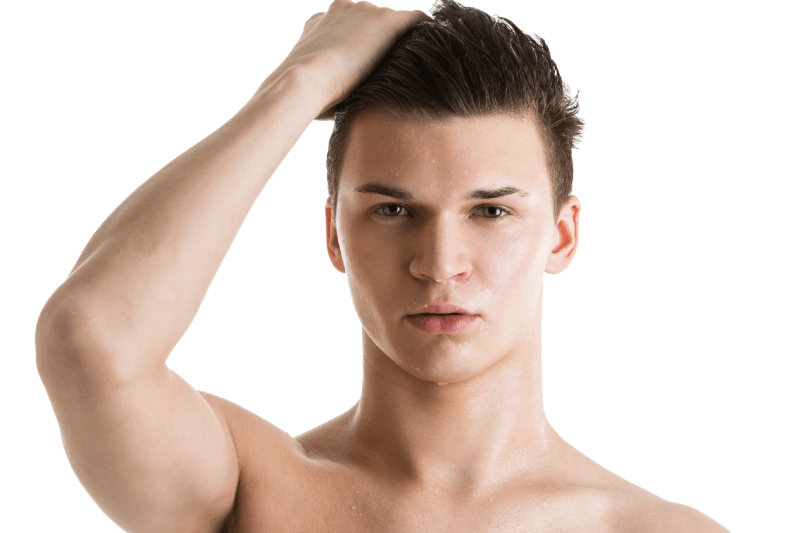
Can Individuals With Chronic Diseases Undergo Hair Transplantation?
It is possible for individuals with chronic diseases such as diabetes, high blood pressure, or heart conditions to undergo a hair transplant, but this absolutely requires physician approval and detailed medical evaluation. Before the operation, the patient’s general health status, blood tests, and medications used are thoroughly examined. The procedure can be performed, provided the disease is under control and necessary precautions are taken. It is vital that the patient informs the clinic transparently about their health condition and all medications they are taking.
When Can A Hat Be Worn After Hair Transplantation?
Wearing a hat after a hair transplant is important to protect the transplanted grafts and avoid direct sunlight. However, special care is needed to ensure it does not put pressure on the recipient area. Generally, a wide, loose hat (such as a bucket hat) that does not make contact with the scalp can be worn for 10 to 14 days after the operation. After this period, wearing regular hats is usually permitted, but the physician’s instructions must be strictly followed.
Are There Special Techniques For Different Hair Types (Curly, Fine Hair)?
Yes, special techniques and approaches are used to optimise the transplantation process for different hair types. For instance, curly hair (including Afro-type hair) may require special, wider punches and careful extraction during the FUE technique because the roots grow in a curved manner beneath the skin. For fine hair, denser implantation or the DHI technique may be preferred to increase the feeling of density. Experienced teams aim to achieve natural and dense results by using the most appropriate method and instruments specific to each hair type.
What Type Of Anaesthesia Is Used In Hair Transplantation And Are There Side Effects?
Hair transplant operations are generally performed under local anaesthesia. This means the patient is awake during the procedure, but only the scalp is numbed. Local anaesthesia is much safer than general anaesthesia, and the risk of serious side effects is extremely low. Occasionally, dizziness, mild blood pressure drop, or allergic reactions may occur, but an experienced team is prepared to manage such situations. Thanks to local anaesthesia, the patient can return to their normal activities immediately after the operation.
What Are The Reasons For A High Failure Rate In Hair Transplantation?
The main reasons for a high failure rate in hair transplantation include an inexperienced team, a non-sterile environment, grafts being kept outside the body for too long, and the patient’s non-compliance with post-operative instructions. Grafts losing viability or contracting an infection can lead to an unsuccessful outcome. Therefore, it is critical to choose centres with international accreditations, strong references, and high hygiene standards. Institutional intermediaries like Cure Holiday recommend clinics where these risks are minimised.
When Can Shaving Or Hair Cutting Be Done After Hair Transplantation?
The timing for hair cutting or shaving after a hair transplant is important and differs for the two areas. Hair in the donor area can usually be cut with scissors or a protective comb one month after the operation. However, patients are advised to wait at least three to six months before shaving or using clippers on the transplanted area. This period is necessary for the transplanted hair follicles to fully strengthen and settle. Not rushing this process preserves the quality of the final result.
What Oils Or Lotions Are Recommended After Hair Transplantation?
After hair transplantation, physicians typically recommend special lotions and oils that accelerate healing and nourish the hair follicles. These include special lotions used during the first wash, which soften the scabs and provide moisture. Additionally, some clinics may recommend natural oils (e.g., argan or almond oil) or special peptide-based serums to support scalp health and hair growth. It is crucial to use the products prescribed by the physician and only apply approved substances to the transplanted area.
What Are The Hygiene Standards Of Hair Transplant Clinics In Turkey?
Clinics operating within the scope of health tourism in Turkey and accepting international patients are required to comply with high hygiene protocols that meet European and global standards. Operations are generally performed in sterile operating rooms of fully equipped hospitals or specialised surgical centres. The use of single-use instruments and the application of regular disinfection and sterilisation processes reduce the risk of infection to almost zero. These high hygiene standards are fundamental conditions for patient safety and operation success.
When Can Hair Dyeing Or Chemical Treatments Be Done After Hair Transplantation?
A long wait is required before hair dyeing or chemical processes like perming can be performed after a hair transplant. Chemicals can damage the sensitive hair follicles and the healing skin in the recipient area. It is strongly advised to wait at least four to six months for dyeing without chemical contact to the transplanted area. This period is critical to ensure that the hair follicles are fully settled and the scalp is healed. Chemical treatments should be avoided without the physician’s approval.
What Is The Best Age Range For Hair Transplantation?
The ideal age range for a hair transplant depends on the type of hair loss and the patient’s general health, but it is generally between 25 and 55 years old. Transplantation is usually not recommended for young individuals under 20 because the hair loss pattern has not yet fully stabilised. Ideally, one should wait for the hair loss to enter a stable phase. Specialists determine the most appropriate timing by evaluating the individual’s current hair loss situation. This is a vital step for achieving both successful and long-term satisfactory results.
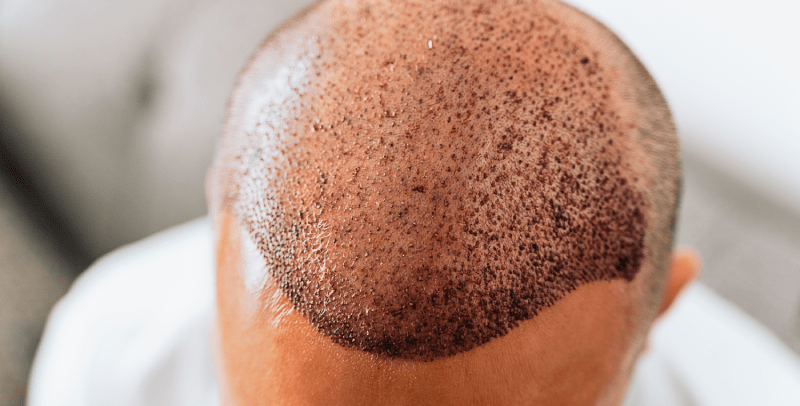
What Should Be Considered When Flying After Hair Transplantation?
Flying after a hair transplant is generally safe, but certain precautions should be taken. Especially within the first 24-48 hours, heavy lifting and strenuous activities should be avoided to prevent changes in blood pressure. During the flight, care must be taken to ensure the transplanted area does not touch the headrest or any surface. The comfortable services provided for your airport transfers and accommodation make this challenging part of the journey easier. Cure Holiday will provide you with all necessary warnings before your flight.
When Can A Second Hair Transplant (Densification) Be Performed?
A second hair transplant procedure (usually to increase existing hair density or fill areas where loss has progressed) can generally be performed at least 12 months after the initial operation. This one-year period is critical for the first transplanted hair to fully grow out and for the donor area to completely heal. Since the capacity of the donor area is limited, a detailed analysis of this area must be performed before the decision for a second transplant is made.
Are Massages Or Scalp Treatments Recommended After Hair Transplantation?
Massages or harsh scalp treatments are absolutely not recommended in the first months after a hair transplant. Applying pressure or friction to the transplanted area within the first month can damage the grafts. However, after about four months, gentle scalp massage may be beneficial to stimulate hair growth and increase blood circulation. Before starting such treatments, you should always consult your clinic and obtain their approval.
What Is Considered The Upper Age Limit For Hair Transplantation In Turkey?
There is no definitive upper age limit for a hair transplant. Success depends on the patient’s chronic illnesses being under control, their general health status, and the quality and density of the donor area. Healthy individuals over 65-70 years old can also achieve successful results. The important thing is for the physician to conduct a comprehensive assessment to clearly determine the risks and expected outcomes of the operation. Age, by itself, is not a limiting factor.
This detailed guide has provided you with comprehensive information about your hair transplant journey in Turkey. Turkey is an excellent choice for hair transplantation thanks to its cost advantage and high success rates.
To plan your treatment process, learn all the logistical details, and receive a personalized package price, contact the experts at Cure Holiday and take the first step in your hair restoration journey with confidence.
Which of these 35 questions would you like to delve deeper into, such as the Precise Differences Between FUE and DHI Techniques or the Details of the Post-Transplant Recovery Process?
